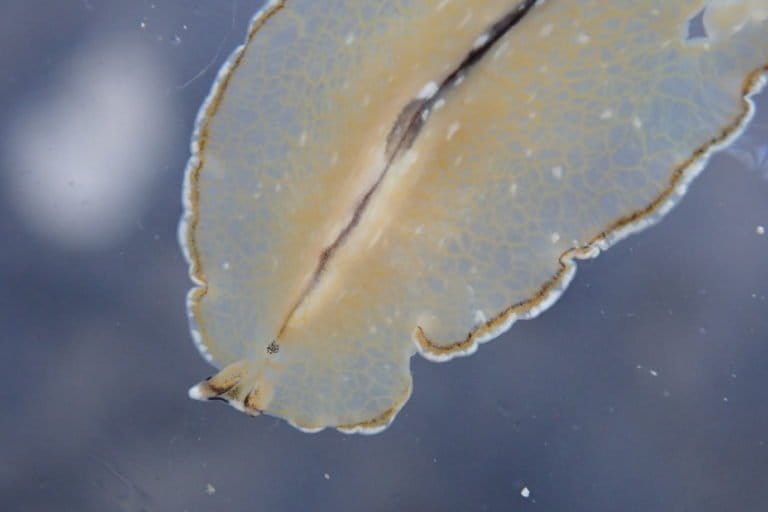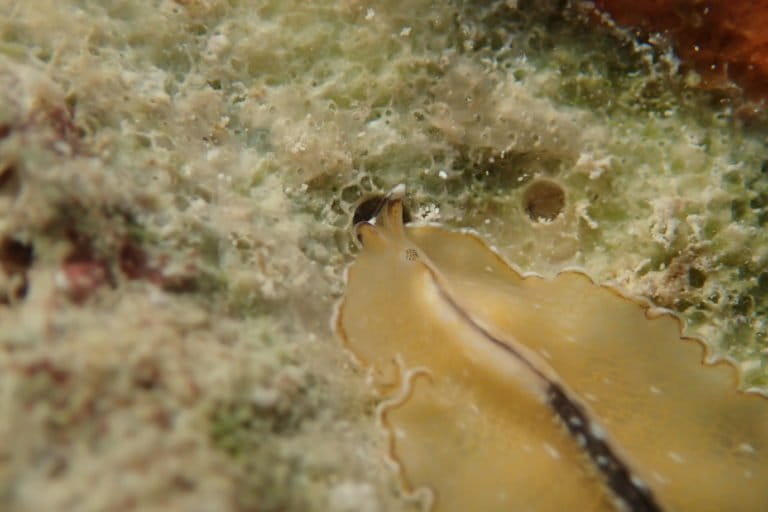- Marine flatworms are tiny creatures with a highly branched digestive system and are often known for their bright colours. Some species are difficult to collect and fix in the laboratory for viewing under the microscope because of their fragile bodies.
- The new flatworm species has knobbed pseudotentacles, which are found in flatworms from the genus Bulaceros.
- Researchers expect many more new species of marine flatworms to be discovered from the unexplored Lakshadweep archipelago, the only coral atolls in India and a hotspot of marine faunal biodiversity.
A new species of marine flatworm has been discovered from the coral atolls of the Lakshadweep archipelago located in the Arabian Sea off the west coast of southern India in a biodiversity survey by researchers. The live flatworm is oval-shaped and features a translucent body with numerous visible branches of the brown gut, a dark black band in the middle, irregular white spots on the top and a margin of white spots. It is the second species described under the genus Bulaceros and the first report of this genus outside of the Pacific Ocean.
With the help of a paintbrush, Sudhanshu Dixit gently lifted two flatworm specimens ranging from two to four centimetres in length, during low tide in the intertidal areas (above the water at low tide and submerged at high tide) of Agatti Island in 2019 and Kavaratti Island in 2020. “Many of the species of these worms are very soft and delicate and can break even with the slightest touch of our hands, a spatula or forceps,” he told Mongabay-India. Dixit, is a project scientist at the Centre for Marine Living Resources and Ecology in Kochi and lead author of the study. He adds that he always goes equipped with paintbrushes and small containers while going to the field, be it an intertidal area or subtidal area when he is diving.
The first specimen from Agatti Island, which was used to describe the new species, was spotted when he overturned a medium-sized rock covered with algae, while the other specimen was hidden under a submerged wooden block. The first flatworm specimen was hard to find as it was translucent, said Dixit, and he could only detect it when it started crawling. “I was kind of sure that it can be a new species the moment I spotted and collected it as I remember seeing a similar-looking polyclad (marine flatworm) somewhere in some publication or book which was undescribed.”

Marine flatworms are tiny (ranging in length from 1 cm to 4 cm) soft-bodied predators that hunt and feed on a variety of invertebrates such as molluscs and sponges. One of the least studied marine faunal groups of India, marine flatworms, belonging to the order Polycladida, are free-living as opposed to most other flatworms that are parasites living inside other animals. Known for their extraordinary colours and patterns, these cryptic creatures are most active at night, crawling under rocks in search of food.
Having a highly branched digestive system, marine flatworms are named ‘polyclads’ (meaning ‘many branches’). “These animals have a gut with only one opening, which is used for both ingestion and excretion unlike the majority of animals with a separate mouth and anal opening,” added Dixit. In 2019, he described and published two new species from Agatti Island, namely Pseudoceros agattiensis and Pseudoceros stellans.
“In many parts of the world, where bivalve culture is done at large scale, some polyclad species commonly called oyster leeches are known to consume and kill oysters, harming the livelihood of people connected to their farming,” Dixit said.

Knobbed pseudotentacles
Dixit and his colleagues Hashim Manjebrayakath and N. Saravanane photographed the specimens collected from the intertidal areas of Agatti and Kavaratti Islands. The animals were observed under the microscope for key external morphological characters such as their eyes and tentacles. At first, Dixit was unsure of the genus of the flatworms and thought it might be Pseudoceros but when he started taking photos of the specimen in a petri dish, he got a clue. “I noticed small knobs on its ear-like pseudotentacles, which distinguish the genus Bulaceros with the genus Pseudoceros.”
This species was first collected in 1992 from Papua New Guinea and was published as Bulaceros sp. in 1996 because of a lack of information regarding its internal details, explained Dixit. Now, Dixit’s team has formally described the species. They named it Bulaceros newcannorum after two eminent researchers from Australia, Leslie J. Newman and Lester R.G. Cannon, who published the first information about the species and in honour of their contribution to the field of polyclad taxonomy.
Even for a trained eye, marine flatworms are hard to spot because of their small size. Upon successful collection, marine biologists preserve or ‘fix’ flatworms for viewing under the microscope to identify the species; fixatives such as formalin or ethyl alcohol are used. However, marine flatworms are challenging to work on because of the difficulty in preserving them. During the process of fixation, Dixit observed that flatworms from the genus Acanthozoon and Bulaceros tend to break or curl. This could be one reason why such a low number of species under certain genera are described, he believes.

Many species waiting to be discovered
While about 1020 species of marine flatworms occur worldwide, only 68 are described from India, as per unpublished data, Dixit states. “The first study on Polyclads was published in 1902 by British naturalist F.F. Laidlaw from Lakshadweep and after that, there was not even a single study till 2011 (a gap of 110 years),” noted Dixit. The first polyclad described from independent India by an Indian researcher was by Dixit in 2017.
“Such finds are vital to understanding the real diversity of our marine realm” and “will help us understand these ecosystems and their diversity better and will help develop a better conservation blueprint,” said marine ecologist Deepak Apte and former director of the Bombay Natural History Society. “It is heartening to see young researchers doing some excellent taxonomic work, which otherwise is fading away rapidly,” he added.
The only coral atolls of the country, the Lakshadweep archipelago consists of 36 islands that harbour rich marine faunal biodiversity. Until now, Dixit has described five new species of free-living marine flatworms from Agatti and Kavaratti island alone. “So, you can imagine how many species must be there waiting to be described in the remaining islands,” said Dixit, adding that more surveys are needed to explore the biodiversity of reef-associated fauna.
In fact, Dixit collected some species in the past, which he says were definitely new but he was unable to fix them successfully because of their fragile bodies and as a result, he could not describe them. In future, he plans to continue hunting for new species in the Lakshadweep Islands and he hopes to incorporate DNA studies to understand the phylogeny of Indian polyclads. “DNA studies can also help to unravel various taxonomic confusion regarding cryptic species.”

CITATION:
Dixit, S., Manjebrayakath, H., & Saravanane, N. (2020). A rare polyclad genus Bulaceros (Platyhelminthes: Polycladida: Pseudocerotidae): new species and new record from Indian coral atolls. Marine Biology Research, 16(8-9), 632-642.
Banner image: Bulaceros newcannorum. Photo from the Centre for Marine Living Resources and Ecology (CMLRE).
